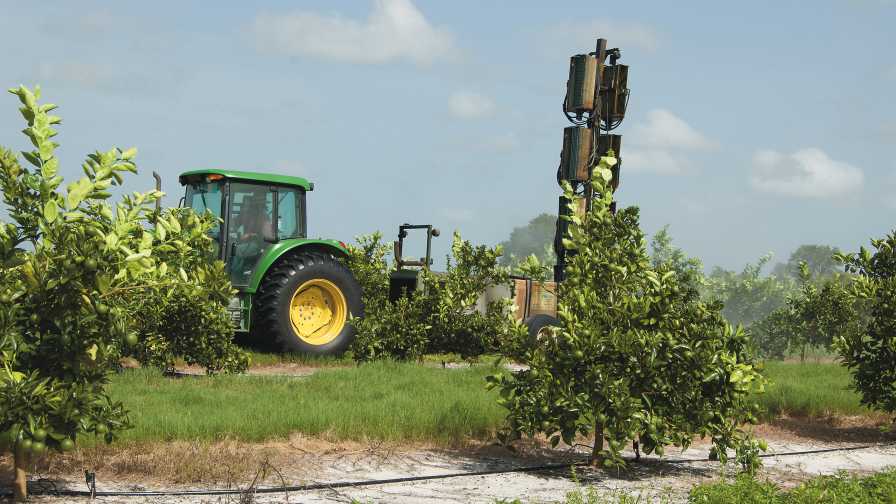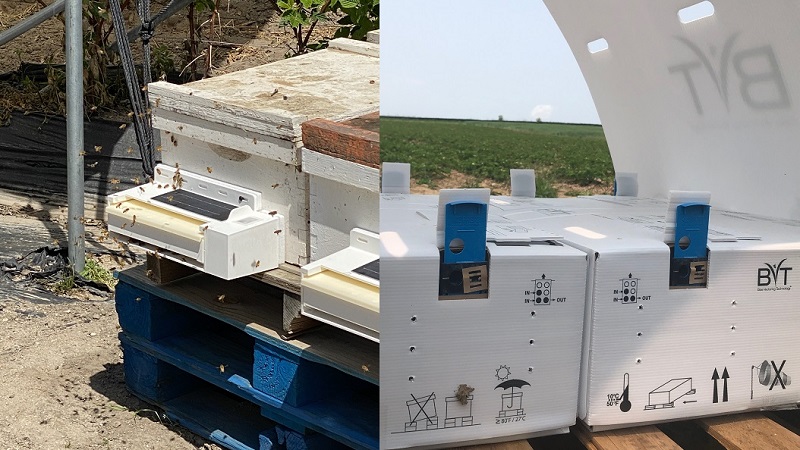Best Practices For Bactericides Key To Vetting Citrus Solution

Bactericide applications during cooler times of the year, when HLB bacteria is more active, will be most effective.
Photo by Frank Giles
Without a doubt, the biggest news in Florida citrus during 2016 was the clearance for applications of three bactericide products aimed at improving the health of HLB-infected trees.
The products, FireWall 50 (streptomycin, AgroSource), FireLine 17 (oxytetracycline, AgroSource), and Mycoshield (oxytetracycline, NuFarm) were first approved by a crisis declaration from Florida Commissioner of Agriculture Adam Putnam, which cleared the way for spring flush applications of the products. Subsequently, a Section 18 was granted by EPA for continued applications for the remainder of the year.
The Section 18 was more difficult than most because applications were intended to improve tree health. According to the Florida Fruit & Vegetable Association (FFVA), who is the official petitioner on behalf of the registrants, the documentation sent to FDACS supporting the exemption was four times larger than usual petitions.
“We were very fortunate to have gotten there so quickly,” says Taw Richardson, President and CEO of AgroSource. “We also were fortunate to have Commissioner Putnam who was willing to jump in and push the envelope and his FDACS team for the crisis exemption in March and then the Section 18 that came in August. Without them and FFVA, none of this happens.”
How Do The Trees Look?
Now, with most growers having applied several applications of the bactericides, all eyes are on the trees looking for clues if the materials are having the intended effect of improving tree health, reducing fruit drop, and improving yields.
Most growers are in agreement that trees do look better than last season. How much of that can be attributed to the bactericides or to a season of good growing weather is still open to question.
“I think a high percentage of the growers are seeing tree health improvement, but it is too early to tell to what extent the yields have or will increase,” says Steve Futch, a Regional Citrus Extension Agent based in Southwest Florida.
While it is still early, Richardson says there are some good signs that trees are responding the way research plots indicated they would.
“Our trials do tell us what we see behind both canker and HLB treatments of these products. We have been sticking fruit on trees,” he says. “We would anticipate that to be happening, but there is still some question of how much is based on their [spray] program or how much of it is other factors. Or, how well will the trees continue to hold the fruit later in the season?”
The USDA’s November 2016-2017 Florida citrus production estimate rose by 2 million boxes based on a lowering of the percentage of anticipated fruit drop. Regardless of the cause, it’s a welcome sign for growers.
“As long as growers are staying on the recommended programs, we feel like after two years, we should be able to nail down what is happening and allow growers to feel more confident they are seeing positive results with the bactericides on tree health,” Richardson says.
Best Practices
Richardson says he is very pleased that growers seem to be following technical recommendations on applying the bactericides.
“When we saw results of the Citrus Research and Development Foundation survey on bactericide usage for the early season and growers’ plans for balance of the season, it appears they have really followed the program we have recommended,” he says.
Growers appear to be rotating the active ingredients to avoid potential resistance and making a sufficient enough number of applications to take full advantage of the materials.
“We are recommending growers rotate active ingredients depending on the citrus type and the time of the season,” he says.
“We want growers to cluster applications during the cooler times of year when the HLB bacteria is most active. So, we are looking at late summer to early fall applications followed by late winter to spring applications. Right now (at presstime), we think growers on a full program have made about four applications.”
Richardson stresses that applying the bactericides with the recommended adjuvants is critical to performance.
“The recommendations on adjuvants are based on significant research on their ability to move the active ingredients of FireWall and FireLine into the tree systemically,” he says. “That was the biggest part of our early research and the real breakthrough proving we can get these products in the tree where they can kill the HLB bacteria.”
Most growers are applying bactericides in the tank with other materials that are part of their regular production programs. There have been no significant reports of problems associated with tank-mixing the bactericides.
Labels and technical bulletins on pro-per application methods can be found on the company websites at (AgroSource.net) and (NuFarm.com).










